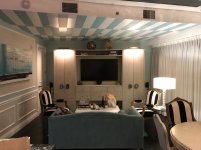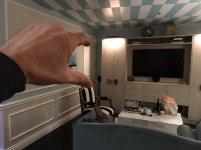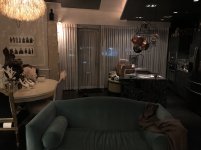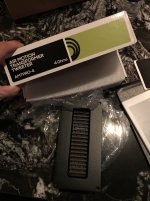That’s a good point.
What do you think of these? These are nice. How do I know if they are directional or if they have a good amount of dispersion?
Fountek Neo X 3.0 Ribbon Tweeter Silver
What do you think of these? These are nice. How do I know if they are directional or if they have a good amount of dispersion?
Fountek Neo X 3.0 Ribbon Tweeter Silver
-vertical dispersion won't be as good higher in freq. when compared to a dome tweeter.
Neo CD 2.0 (same basic driver) graph here shows what happens vertically off-axis with pressure loss:
Zaph|Audio
Neo CD 2.0 (same basic driver) graph here shows what happens vertically off-axis with pressure loss:
Zaph|Audio
Last edited:
It's worse (more directive) in 3 different contexts:
1. Depending on the HRTF's of the listener, somewhere between about 6.5 kHz and 8 kHz is a prominent cue for elevation or image height. A loss in pressure even 30 degrees vertical off-axis can effect this result negativly.
2. Image depth is aided with longer arrival and stronger intensity vertical reflections from the room at higher freq.s.
3. In the context of home theater and ceiling-mount or in-ceiling you can end-up with a horizontal depression at higher freq.s depending on where you sit relative to each left and right surround channel.
1 & 2 can be mitigated to an extent with a reward slant baffle (and a complimentary pole network) that puts the listener near the bottom of the line-source (near the bottom of the ribbon) with plenty of high freq. sound aimed toward the ceiling.
1. Depending on the HRTF's of the listener, somewhere between about 6.5 kHz and 8 kHz is a prominent cue for elevation or image height. A loss in pressure even 30 degrees vertical off-axis can effect this result negativly.
2. Image depth is aided with longer arrival and stronger intensity vertical reflections from the room at higher freq.s.
3. In the context of home theater and ceiling-mount or in-ceiling you can end-up with a horizontal depression at higher freq.s depending on where you sit relative to each left and right surround channel.
1 & 2 can be mitigated to an extent with a reward slant baffle (and a complimentary pole network) that puts the listener near the bottom of the line-source (near the bottom of the ribbon) with plenty of high freq. sound aimed toward the ceiling.
Thanks all for the reply. With the ribbon tweeters or Planar I was trying to eliminate floor and ceiling bounce and have it more come in as a frontal wave. Tonight I'm going to make a video of the room and post here. I did find a video of the horizontal dispersion of the Dayton Audio Planar Tweeter and I think that would be sufficient. It's just the vertical dispersion we have to check in on.
Will keep everyone posted.
Thanks!
Joey
Will keep everyone posted.
Thanks!
Joey
With the ribbon tweeters or Planar I was trying to eliminate floor and ceiling bounce and have it more come in as a frontal wave.
This is counter-productive to good sound.
"Floor-bounce" is a fairly specific resulting null (grouping of nulls) relative to the listener.
Calculator:
Floor/Ceiling Reflection Calculator
-with typical results its no where near the treble region (1.5 kHz and above), instead its a *midrange* problem.
Even then its debatable that reducing the effects of floor-bounce is particularly beneficial (..because of mental adaptation). Plus, a design that substantively reduces this is usually very particular and comes with its own problems.
@ Scott. Your example shows that dispersion is situation dependent. That was my point, I was talking semantics. If a newbie was reading and thought that one or the other was better they might go out and build something needlessly extreme.
It's true that the in-ceiling surround is situation dependent.

..but,
For a fairly typical use (floor-"tower"/stand speakers near), a point-source tweeter is usually better (at least when just concerning yourself with dispersion).
Ironically *this* (maLx) poster thinks that a more vertically directive tweeter is better. It's usually not, and it's more difficult to achieve over the entire tweeter's bandwidth. Top two octaves, sure (though increasingly less as freq.s lower).
Actually when considering uniformity of reflections relative to direct sound, something approaching omni is preferable for a tweeter. (..but not realistic for most loudspeaker designs.)
Ok so here is my living room.

This is the problem I am trying to solve.
When I am sitting in that couch that is when I am watching a movie. There’s literally only two places to sit my Condo is small.
When I want to listen to music... I am also sitting on that couch. But I would only be using the left and right channel. All other speakers would be off.
The loudspeakers I want to build I want the midrange and tweeeter to be mounted high enough where it comes over the chair.

I figured if I got a ribbon tweeter and mid range, it would fill that area with sound and the sound would come like a frontal wave.
Here is a pic of the other side of the room with me standing directly at the center channel and looking away from the TV. When I entertain people sitting at the kitchen counter... I want the left and right loudspeakers to be able to have sound directed at them. That’s why I thought if I mounted the ribbon tweeter mtm style it would mostly be ear level at all times

This is why I got this tweeter because I figured maybe if this was mounted vertically left and right the sound would sweep past me but also at me since they have nice horizontal dispersion, but it won’t reflect off the ceiling and hit me while I’m sitting because it does not disperse vertically.

Hopefully that helps you guys recommend some drivers.
Let me know if any of you that have been helping me have some feedback on what to get! Would love to get this process started.
Thanks!

This is the problem I am trying to solve.
When I am sitting in that couch that is when I am watching a movie. There’s literally only two places to sit my Condo is small.
When I want to listen to music... I am also sitting on that couch. But I would only be using the left and right channel. All other speakers would be off.
The loudspeakers I want to build I want the midrange and tweeeter to be mounted high enough where it comes over the chair.

I figured if I got a ribbon tweeter and mid range, it would fill that area with sound and the sound would come like a frontal wave.
Here is a pic of the other side of the room with me standing directly at the center channel and looking away from the TV. When I entertain people sitting at the kitchen counter... I want the left and right loudspeakers to be able to have sound directed at them. That’s why I thought if I mounted the ribbon tweeter mtm style it would mostly be ear level at all times

This is why I got this tweeter because I figured maybe if this was mounted vertically left and right the sound would sweep past me but also at me since they have nice horizontal dispersion, but it won’t reflect off the ceiling and hit me while I’m sitting because it does not disperse vertically.

Hopefully that helps you guys recommend some drivers.
Let me know if any of you that have been helping me have some feedback on what to get! Would love to get this process started.
Thanks!
..or at least a driver configuration.recommend some drivers.
If you are to have them closer to the ceiling and want to reduce the ceiling reflection then you might benefit from an absorber in addition.
It is a fair challenge to hold the same directivity over say five octaves, but it can be done. The reflected tone is consistent (this is the point, isn't it?), just lower in level. Then, as you say the story changes slightly in the midrange.ScottG said:that a more vertically directive tweeter is better. It's usually not, and it's more difficult to achieve over the entire tweeter's bandwidth. Top two octaves, sure (though increasingly less as freq.s lower).
@scottg I didn’t say a more vertically directive tweeter was better. In fact I was under the impression that the Dayton Audio tweeter I posted in that photo dispersed horizontally. Is that not the case? And if it is, isn’t that what I need? I’m not saying that speaker, but I’m hoping that a nice planar or ribbon style tweeter for my upper and midrange is achieveable, then, use a 6.5” woofer for the 200hz to maybe 700hz range and then I have my two 10” subs for my 100-200 and 100-below. Let me know thoughts.
Hi, Everyone.
So after some more research here's what I think I want to use and here are my additional questions. Let me know what you guys thing!
For the center channel:
One Neo 8 PDR (Bohlender Graebener Neo8-PDR Planar Transducer)
Two Focal Access 4" Midrange Woofers (165A3" Midrange Speaker - Focal Replacement for HP100-A3)
For the left and right speakers:
Two Neo 8 PDRs each mounted slightly off access for better dispersion (maybe I'm saying this wrong)
One of these each Morel Drivers Morel TSCM 634 Titanium Supreme Series 6" Midrange 4 Ohm
In a 3 Way Design
For the rear surrond speakers one Neo 8 PDRs each.
For the Atmos speakers above my head one Neo 8 PDRs each.
So here are my questions.
1: What crossovers should I use for the left, right, and center channel?
2: I imagine I won't need crossovers for the speakers above my head and for the rear because I can do that electronically in my receiver and only push 500hz and above to them
3: Will I need any seperate amplification for the larger woofers? I'm probably going to use a Pioneer Elite VSX-LX102 or similar because they do 170w/channel at 4ohm.
Let me know!
Joey
So after some more research here's what I think I want to use and here are my additional questions. Let me know what you guys thing!
For the center channel:
One Neo 8 PDR (Bohlender Graebener Neo8-PDR Planar Transducer)
Two Focal Access 4" Midrange Woofers (165A3" Midrange Speaker - Focal Replacement for HP100-A3)
For the left and right speakers:
Two Neo 8 PDRs each mounted slightly off access for better dispersion (maybe I'm saying this wrong)
One of these each Morel Drivers Morel TSCM 634 Titanium Supreme Series 6" Midrange 4 Ohm
In a 3 Way Design
For the rear surrond speakers one Neo 8 PDRs each.
For the Atmos speakers above my head one Neo 8 PDRs each.
So here are my questions.
1: What crossovers should I use for the left, right, and center channel?
2: I imagine I won't need crossovers for the speakers above my head and for the rear because I can do that electronically in my receiver and only push 500hz and above to them
3: Will I need any seperate amplification for the larger woofers? I'm probably going to use a Pioneer Elite VSX-LX102 or similar because they do 170w/channel at 4ohm.
Let me know!
Joey
A tall stack can give a more narrow directivity in the vertical plane, and the narrow width will disperse more widely in the horizontal plane.. but offsetting them would be unusual.Two Neo 8 PDRs each mounted slightly off access for better dispersion (maybe I'm saying this wrong)
This is a big question, where are you at with it?1: What crossovers should I use for the left, right, and center channel?
The unmentioned side of crossing is equalisation. This could be to attend to driver resonances, baffle concerns and room/power considerations so if you can also do that...2: I imagine I won't need crossovers for the speakers above my head and for the rear because I can do that electronically
Still researching. Do you guys think that these drivers would play nice and offer good dispersion in the high range? Not sure what the dispersion of the Aurum is. Can someone help me there?
For the left and right speakers I'd use all 3. For the center channel, speakers above me, and rear surronds, I'd just use the BG and Aurums.
Aurum Cantus AST2560 Aero Striction Tweeter
Bohlender Graebener Neo8-PDR Planar Transducer
Morel SCM 634 Supreme 6" Midrange
For the left and right speakers I'd use all 3. For the center channel, speakers above me, and rear surronds, I'd just use the BG and Aurums.
Aurum Cantus AST2560 Aero Striction Tweeter
Bohlender Graebener Neo8-PDR Planar Transducer
Morel SCM 634 Supreme 6" Midrange
Neo 8's won't go low enough for any channels, nor with 10's - you need something that goes to at least 80 Hz.
- Status
- This old topic is closed. If you want to reopen this topic, contact a moderator using the "Report Post" button.
- Home
- Loudspeakers
- Multi-Way
- Components Questions
 @maLx - please stop quoting the post above yours when replying.
@maLx - please stop quoting the post above yours when replying.